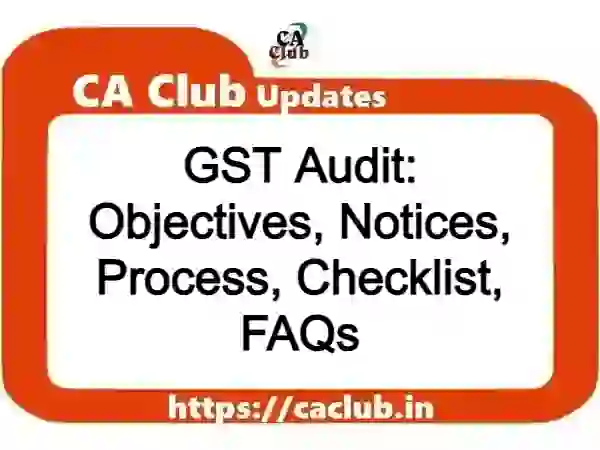The Goods and Services Tax (GST) regime has brought uniformity in taxation of goods and services across India. It has paved the way for a simplified tax structure. Audit under GST is an important tool to verify compliance levels of taxpayers as per GST laws.
GST audit aims to bring transparency, deter tax evasion and guide businesses towards compliance accuracy. It involves scrutiny of taxpayer’s transactions to validate reported GST liability.
Objectives of GST Audit
i) Examine records, returns and documents of taxpayers
ii) Verify correctness of turnover, taxes paid, refunds claimed and input tax credit availed
iii) Assess compliance with GST Acts and Rules
iv) Educate taxpayers for better compliance
GST Audit Process
i) Taxpayer is notified of audit at least 15 days in advance through FORM GST ADT-01
ii) Documents to be submitted are listed in FORM GST ADT-01
iii) 15 days given for document submission
iv) Audit commences on acceptance of documents or verification at business premises
v) Preliminary findings shared and taxpayer’s views recorded
vi) Final audit report in FORM GST ADT-02 within 30 days
vii) Taxpayer can make payment to waive show cause notice
viii) Entire process to be completed within 3 months, extendable by 6 months
Information Required for GST Audit
Taxpayer required to submit:
i) Inward and outward supply details
ii) Details of goods produced/manufactured
iii) Input tax credit availed
iv) Output tax payable and paid
v) Balance sheet, P&L with schedules
vi) Annual returns filed with Registrar of Companies
vii) Income Tax returns and audit reports u/s 44AB of Income Tax Act
viii) Directors/Auditors report
ix) Cost audit report u/s 148 of Companies Act 2013
x) FORM 26AS
xi) Details of cases booked by DGGI/Anti-evasion wing
xii) VAT annual returns
xiii) List of major input supplies with HSN codes and GST rates
Taxpayer to provide necessary facilities and information for timely audit.
Frequent Issues Detected in GST Audit
Some common issues detected during GST audits include:
i) Short payment or non-payment of taxes
ii) Wrong classification of goods/services
iii) Excess or short tax payment due to improper calculations
iv) Collecting tax from customers but not depositing with government
v) Wrong input tax credit availment on ineligible documents
vi) Non-payment of tax on advances in case of services
vii) Non-compliance with Reverse Charge Mechanism
Benefits of GST Audit to Taxpayers
i) Enhanced tax compliance
ii) Accuracy in filing GST returns
iii) Identifying deficiencies in accounting and internal controls
iv) Lesser tax disputes and legal proceedings
v) Understanding GST laws and procedures better
Important Aspects of GST Audit
i) Risk-based selection of taxpayers
ii) Systematic and comprehensive approach
iii) Scrutiny based on risk factors and materiality
iv) Detailed recording of audit observations
v) Identify unexplored compliance areas
vi) Educate taxpayers for voluntary compliance
Frequently Asked Questions
Q1. What is audit under CGST?
Audit under CGST involves examination of records, returns and documents related to input tax credit and refunds to validate tax payments and compliance.
Q2. Which documents are examined during audit?
Documents maintained by taxpayer, furnished by taxpayer under GST laws or any other law are examined.
Q3. Where can a taxpayer’s audit be conducted?
Audit can be done at tax authority’s office or taxpayer’s business premises. Desk-based audit mandated for small taxpayers.
Q4. What are the timelines for a GST audit?
15 days notice through FORM GST ADT-01. Entire process to be completed in 3 months extendable by 6 months.
Q5. What documents are required from taxpayers for GST audit?
Inward/outward supply details, goods produced, ITC availed, output tax payable/paid have to be submitted.
Conclusion
GST audit is an important tool to verify taxpayer’s compliance, ensure accuracy in reporting GST liability and guiding them towards voluntary compliance. A systematic audit process coupled with education of taxpayers can enhance compliance levels and transparency in the system.
CBIC Information Brochure on GST Audit (Nov. 2023)
